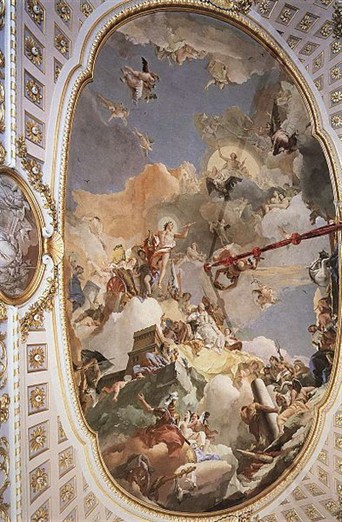Giambattista Tiepolo’s years in Madrid
 The biggest star of European Rococo painting, the Venetian Giambattista Tiepolo, spent the last years of his life in Madrid, where he died suddenly on 27 March, 1770 at age 74. He had been summoned to court in 1762 by Charles III with the task of decorating the new Royal Palace, built from 1735, designed by Filippo Juvarra and finished by his collaborator Sacchetti. Tiepolo arrived in Spain after three months of an exhausting journey, accompanied by his sons Giandomenico and Lorenzo. In the vast halls of the new building he worked on three ceilings: the Glory of Spain (image) in the Throne Room, undertaken with the help of his children, the Apotheosis of Aeneas in the Hall of Halberdiers and the Apotheosis of the Spanish Monarchy, in the Queen’s Antechamber. The Glory of Spain, completed in 1764 (signed and dated on the frame), glorified the Spanish monarchy, surrounded as it is by several states and assisted by Virtue with neo Veronese traits. The allegories that emphasize Charles III’s qualities are accompanied by the inclusion of historical references such as the gifts brought by Christopher Columbus. Great inventive richness and airy and dilated rhythms are to be found in the Apotheosis of Aeneas, with Time that allows the hero to gain immortality. The Queen’s Antechamber or Saleta shines with the power of the Spanish monarchy, represented as a matron in white robes surrounded by numerous allegorical figures. The inexhaustible power of his narrative style expresses itself with brilliance in the vast decorative cycle. The fresco is presented as a brilliant recapitulation of the previous exploits, but also as a superb test of his ability to dominate perspective and the orchestration of symbols and allegories, merged into a wonderful harmony of light and colour, history and poetry, to enhance the Spanish dynasty. Despite the ample participation of his sons, the frescoes have great homogeneity of style, for the common capability of Giandomenico and Lorenzo to blend in the stylistic forms of their father, translating the will of formal perfection.
The biggest star of European Rococo painting, the Venetian Giambattista Tiepolo, spent the last years of his life in Madrid, where he died suddenly on 27 March, 1770 at age 74. He had been summoned to court in 1762 by Charles III with the task of decorating the new Royal Palace, built from 1735, designed by Filippo Juvarra and finished by his collaborator Sacchetti. Tiepolo arrived in Spain after three months of an exhausting journey, accompanied by his sons Giandomenico and Lorenzo. In the vast halls of the new building he worked on three ceilings: the Glory of Spain (image) in the Throne Room, undertaken with the help of his children, the Apotheosis of Aeneas in the Hall of Halberdiers and the Apotheosis of the Spanish Monarchy, in the Queen’s Antechamber. The Glory of Spain, completed in 1764 (signed and dated on the frame), glorified the Spanish monarchy, surrounded as it is by several states and assisted by Virtue with neo Veronese traits. The allegories that emphasize Charles III’s qualities are accompanied by the inclusion of historical references such as the gifts brought by Christopher Columbus. Great inventive richness and airy and dilated rhythms are to be found in the Apotheosis of Aeneas, with Time that allows the hero to gain immortality. The Queen’s Antechamber or Saleta shines with the power of the Spanish monarchy, represented as a matron in white robes surrounded by numerous allegorical figures. The inexhaustible power of his narrative style expresses itself with brilliance in the vast decorative cycle. The fresco is presented as a brilliant recapitulation of the previous exploits, but also as a superb test of his ability to dominate perspective and the orchestration of symbols and allegories, merged into a wonderful harmony of light and colour, history and poetry, to enhance the Spanish dynasty. Despite the ample participation of his sons, the frescoes have great homogeneity of style, for the common capability of Giandomenico and Lorenzo to blend in the stylistic forms of their father, translating the will of formal perfection.
Two years later, between 1767 and 1769, Tiepolo was engaged in the construction of seven altarpieces for the royal church of Aranjuez (now in Madrid, Prado and the Royal Palace), with figures of saints placed in empty and realistic landscapes. At the same time the prolific artist accomplished those that are considered the extreme masterpieces of his time, that is, the four canvases of the Flight into Egypt, divided between the State Gallery of Stuttgart and the Museu Nacional de Arte Antiga in Lisbon. Characterized by very light colors and a shaky hand, they bring out the resignation of the old artist. However, he still had the strength to accept a final challenging undertaking: the decoration of the collegiate church of San Ildefonso (Saint Ildephonsus) at La Granja, for which, however, he only was able to prepare the preliminary sketch of the Immaculate Conception (now in Dublin, National Gallery).
